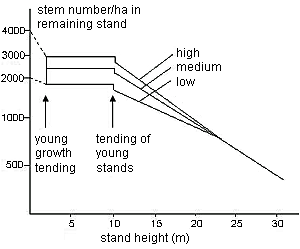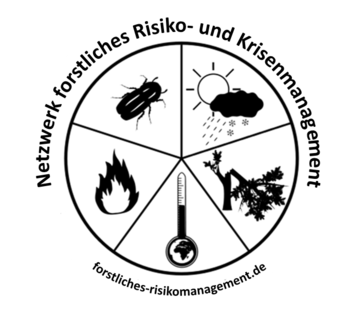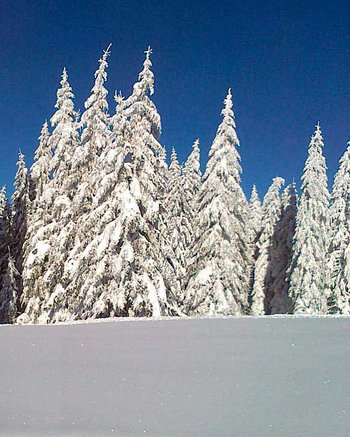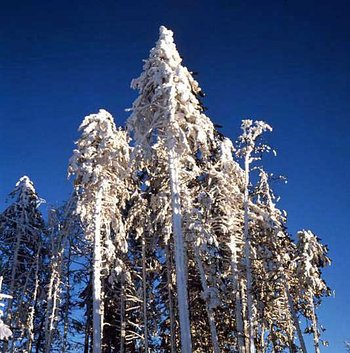Snow and ice damage inflict time and again large damages. They expose weak points for insects and fungi, incremental losses and subsequent throws can also throw operations off the track and lead to economic losses.
Damages caused by snow, rime and ice occur predominantly due to strong laying of wet snow. Soft and hard rime accumulate in fog; glaze ice builds up on branches by freezing rain and gives away under the load, when it is too big and/or it is reinforced by wet snow cover. Countermeasures are tasks of the silviculture and can contribute to prevention.
The preconditions for damages caused by snow and snow-break are met in areas between 350 and 900 m elevation where north and east exposures are sheltered from the wind. Frequent changes between frost and thaw can cause dangerous wet snow which freezes over.
Rime occurs on the other hand in areas with rapidly changing temperatures and humidity, which is typical for bordering regions between continental and oceanic climate. Rime zones can be found in cold air accumulation at elevation from 700 to 900 m above sea level; at northwest and west slopes at 600 to 650 m above sea level.
Breakage from rime can occur locally more often than snow-breaks (for example the east side of the Ore Mountains). Especially endangered are stands with higher share of spruce in the Mittelgebirge, or pine-thickets and pine-pole wood in the lowlands. The average annual damaged wood by snow-break in Bavaria (1954-83) amounts to ca. 630,000 m³, which accounts for 9% of the allowed cut.
Primary damage is defined as breaks (branches and crown breaks; stem, trunk, stock and root throws) with direct ecological and economic impacts. The costs from salvage logging and the wood devaluating process are also included. Secondary damages are medium- and long-term effects which inflict major disruptions to the systematic operations and the consequential losses as a result of the events listed below.
- Loose rock falls and throws; unstable stands; especially in the border area. 15 years later storms still cause loose rock falls and throws.
- Insect damage and fungi diseases; possible large number of potential breeding ground material for further damage (eight-toothed bark beetle and engraver on spruce trees; steelblue jewel beetle on pine trees)
- After the break of tree tips and branches, fungi infections (fungi on pine trees) often cause the trunk to decay.
- Losses in increment to remaining stands; losses in increment after crown breaks can be largely offset, for example in spruce trees with a new top, two tops or bayonet top, but can also substantially add up based on the area.
Trees with a height ranging from 6 to 15 m are especially prone to snow-breaks. A greater stands density during this growth phase has on the one hand a positive effect on the stand quality, but however enhances the danger of breaking under a load of snow. This is significantly high in areas with contact to old trees (edge of old stands/ crown margin of shelterwood). The handling of the stands aims at a compromise between the damage risk and the stand quality, where every owner can balance out for himself according to the site risks and strategies. In this regard, it is important to observe the effects of harvest uses over time (succession of cuttings of age-class forests/secondary felling of selective cutting and shelterwood felling, the number of crowns from which snow slides). If the (neighboring) regeneration grows near a hazardous area, the border should be at least one tree’s length away from the regeneration or the canopy of the overwood should occupy only a fraction of the reproduction area. Canopy of overwood with an average stand density (canopy density of 0.4 to 0.6 degree) has an adverse effect.
Measures when risk is identified

Fig. 3: Tree density guideline: Recommended tree density/ha for pure spruce stands for different snow-break danger.
When the growing stock is in area with high risk, then the selection of tree species should be greatly taken into account. Native provenances and local races have a greater resistance. Thus at vulnerable sites, only provenances and races of suitable origin should be planted and their characteristics through correct silvicultural handling promoted. A preventative risk reduction can be achieved through silvicultural approaches in seeding and mulching, tending of young stands and tending interventions. These affect among other things the number of trees and growing space, crown length and stem form as well as the social position in the stand. Boundary effects and their minimization by shaping forest fringes or maintaining spatial order play above all a role in the currently prevailing age-class forest.
In literature there are numerous manuals for determining the regional and site dangers for stands, which present the first step of threat assessment. Danger classes can be identified and assigned using statistics and maps of damages. Danger classes were first established in 1985 in the GDR. However, as they are not binding these are only useful when making a choice between two opposing options.
When seeding, mulching and tending it should be preventatively kept in mind the growing space (x spruce per ha in snow-break danger, Table 1) and the tree density guideline (Fig. 3). Furthermore, it is recommended to stagger the thinning.
| Tab. 1: The recommended number of plants by the seeding and mulching of spruce plantations depending on the danger of snow-break. | |
| Local threat | Number of plants (unit/ha) |
| high | 1500-2000 |
| middle | 2000-2500 |
| low | 2500-3000 |
When tending young stands especially in natural regeneration, next to protecting from competing vegetation there is also the regulating of mixture of tree species. In the subsequent thicket phase, the focus lies especially with coniferous wood on the stabilizing of the trees against snow-break, which can be achieved by reducing the number of stems. This way the canopy will be loosened and the snow can fall through without causing any damage.
Another option is group afforestation which has been propagated in the mountain forest since the beginning of the 80s. At favorable sites small tree groups are planted relatively compactly in a round or oval form. The group structure leads to an easing of the burden from the snow on the canopy as it blows through the gaps and it does not accumulate in a closed canopy. As the group is constantly exposed to wind, they withstand the stress better than trees in homogenous stands.
Forest Crises Management Advisory Guide
Back to the main page of the Forestry Crisis Management Advisor Guide: Overview of the different topic collections
Back to the article overview in the: Topic Collection: Water in the Forest





